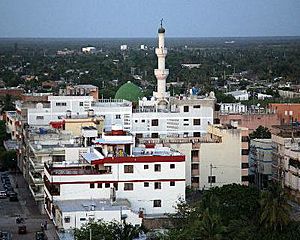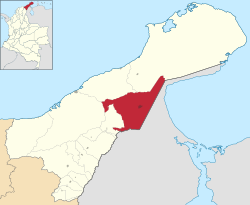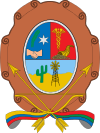Maicao facts for kids
Quick facts for kids
Maicao
|
|||
|---|---|---|---|
|
Municipality and city
|
|||
 |
|||
|
|||

Location of the town and municipality of Maicao in the Department of La Guajira.
|
|||
| Country | Colombia | ||
| Region | Caribbean | ||
| Department | La Guajira | ||
| Foundation | June 27, 1927 | ||
| Area | |||
| • Municipality and city | 1,769 km2 (683 sq mi) | ||
| • Urban | 21.94 km2 (8.47 sq mi) | ||
| Elevation | 52 m (171 ft) | ||
| Population
(2020 est.)
|
|||
| • Municipality and city | 185,072 | ||
| • Density | 104.620/km2 (270.96/sq mi) | ||
| • Urban | 118,889 | ||
| • Urban density | 5,418.8/km2 (14,035/sq mi) | ||
| Demonym(s) | Maicaeros | ||
| Time zone | UTC-5 | ||
| Area code(s) | 57 + 5 | ||
| Climate | Aw | ||
| Website | Official website: http://maicao-laguajira.gov.co/ | ||
| * | |||
Maicao is a city and municipality in the Department of La Guajira, located in northern Colombia. It is about 76 kilometers (47 miles) from Riohacha, which is the capital of the department. Maicao is the second largest city close to the border with Venezuela, after Cúcuta.
The city was started on June 27, 1927. It was founded by Colonel Rodolfo Morales and Tomás Curvelo Iguarán. They established it in the middle of the Wayuu people's land. In the 1970s, Maicao became an important trading center. This happened because of an oil boom in Venezuela and a lot of goods being traded in the Guajira area.
Contents
Etymology
The name Maicao comes from the Wayunaiki language. The word mai-ka-u means "Land of the Maize" or "Land of Corn."
Geography
Maicao is located on the Guajira Peninsula. This is the northernmost part of South America. It is also on the edge of the Guajira desert.
The municipality of Maicao shares borders with several areas. To the north, it borders Uribia and Manaure. To the east, it borders Venezuela. To the south, it borders Albania. To the west, it borders Riohacha. Maicao covers a total area of 1,782 square kilometers (688 square miles). It is about 52 meters (171 feet) above sea level.
Climate
The climate in Maicao changes depending on the area. In the north, it is a hot semi-arid climate. In the south, it is a tropical savanna climate. There are usually two rainy seasons and two dry seasons each year. The average temperature stays between 27 and 29 degrees Celsius (81 to 84 degrees Fahrenheit) all year round.
| Climate data for Maicao (Esc Agr Carraipia), elevation 118 m (387 ft), (1981–2010) | |||||||||||||
|---|---|---|---|---|---|---|---|---|---|---|---|---|---|
| Month | Jan | Feb | Mar | Apr | May | Jun | Jul | Aug | Sep | Oct | Nov | Dec | Year |
| Mean daily maximum °C (°F) | 30.3 (86.5) |
31.3 (88.3) |
32.3 (90.1) |
32.7 (90.9) |
32.9 (91.2) |
32.9 (91.2) |
33.6 (92.5) |
34.2 (93.6) |
33.0 (91.4) |
31.8 (89.2) |
30.7 (87.3) |
30.0 (86.0) |
32.3 (90.1) |
| Daily mean °C (°F) | 25.8 (78.4) |
26.1 (79.0) |
26.7 (80.1) |
27.2 (81.0) |
27.7 (81.9) |
27.9 (82.2) |
28.1 (82.6) |
28.2 (82.8) |
27.6 (81.7) |
27.0 (80.6) |
26.5 (79.7) |
26.0 (78.8) |
27.1 (80.8) |
| Mean daily minimum °C (°F) | 21.5 (70.7) |
21.8 (71.2) |
22.4 (72.3) |
23.0 (73.4) |
23.4 (74.1) |
23.7 (74.7) |
23.7 (74.7) |
23.7 (74.7) |
23.1 (73.6) |
22.5 (72.5) |
22.5 (72.5) |
21.8 (71.2) |
22.8 (73.0) |
| Average precipitation mm (inches) | 19.3 (0.76) |
14.9 (0.59) |
20.8 (0.82) |
72.3 (2.85) |
161.1 (6.34) |
69.5 (2.74) |
42.6 (1.68) |
92.8 (3.65) |
160.7 (6.33) |
214.3 (8.44) |
215.4 (8.48) |
92.7 (3.65) |
1,176.4 (46.31) |
| Average precipitation days | 4 | 4 | 3 | 7 | 11 | 6 | 5 | 9 | 13 | 16 | 16 | 9 | 102 |
| Average relative humidity (%) | 79 | 75 | 73 | 74 | 78 | 77 | 75 | 74 | 79 | 83 | 85 | 84 | 78 |
| Mean monthly sunshine hours | 223.2 | 186.3 | 186.0 | 144.0 | 145.7 | 183.0 | 217.0 | 210.8 | 174.0 | 176.7 | 180.0 | 198.4 | 2,225.1 |
| Mean daily sunshine hours | 7.2 | 6.6 | 6.0 | 4.8 | 4.7 | 6.1 | 7.0 | 6.8 | 5.8 | 5.7 | 6.0 | 6.4 | 6.1 |
| Source: Instituto de Hidrologia Meteorologia y Estudios Ambientales | |||||||||||||
History
Early Days
Before the Spanish arrived, the Wayuu people lived in the Maicao area. The Wayuu people strongly resisted the Spanish. They remained independent until the early 1900s. Maicao was officially founded on June 27, 1927. Colonel Rodolfo Morales and Tomás Curvelo Iguarán founded it for the Department of Magdalena.
Some of the first families to settle there were José Domingo Boscán and Manuel Palacio López. They settled near the Venezuelan border. This area was good because it had fertile land. In 1927, a German company built several wells and windmills. In 1929, Maicao became a "Corregimiento," which is a type of small town, because its population grew. By 1940, about 500 people lived in Maicao.
The Wayuu people used to trade goods through Maicao. These goods came from places like Aruba, Curaçao, Venezuela, and other Caribbean Sea territories. They traded things like coffee, alcohol, and tobacco. In the 1970s, Maicao became a very busy trading center. This was due to an oil boom in Venezuela and the flow of goods in the Guajira area.
Arab Community
Because Maicao is close to the Venezuelan border, many immigrants came to the area. In the 1970s, many Arab immigrants from the Middle East settled in Maicao. They were attracted by the city's trading opportunities. In 1989, the Colombo-Arab College Dar el Arkam was built. Many of these migrants became merchants in the center of Maicao. One of them, José Abuchaibe, who was from Palestine, built the largest building in the city, the Hotel Don Juan. In 1997, Middle Eastern immigrants built the Mosque of Omar Ibn Al-Khattab. It is one of the largest mosques in South America.
Challenges and Changes
During the 1980s and 1990s, the Colombian armed conflict caused difficulties in Maicao. This conflict was between the government and different groups. The situation became harder when Venezuela's economy slowed down. Also, the Colombian government started to control trade more strictly.
In 1991, Maicao was given a special customs status. This was meant to help create jobs. The idea was to let raw materials come in without taxes. Workers would then turn them into finished products. These products could then be sent out of Colombia. This law also allowed some goods to go into Colombia if taxes were paid. However, some goods, like cigarettes, were often traded without paying taxes.
Maicao also received money from coal mining in the Cerrejon mine. However, there were problems with how this money was managed. Sometimes, the money was temporarily stopped. There have been times when locals protested against tax rules. For example, they once burned down a local tax office. The city also faced challenges with people who had to leave their homes because of the conflict. There were also issues with education and healthcare.
Modern Times
On March 19, 2000, the town of Albania became its own municipality. It took about 425 square kilometers (164 square miles) from Maicao. This meant Maicao lost a large area that included part of the coal mine. This also reduced the amount of money Maicao received from mining.
Economy
Most of Maicao's economy, about 90%, comes from trade. The rest is mainly from services. A small part comes from manufacturing. The Chamber of Commerce estimates that there are about 1300 registered stores. In 1992, a special customs zone was created for Maicao, Uribia, and Manaureo. This was done to help regulate trade in the area. One interesting product grown in Maicao is Ahuyama, also known as Cucurbita moschata. This vegetable is processed into flour in Maicao and sold to countries in Europe.
Culture
The Mosque of Omar Ibn Al-Khattab was built in September 1997. It is the third largest mosque in South America. Even though Colombia is mostly a Roman Catholic country, the Maicao region has a large Muslim population from Lebanon. They helped fund and build the mosque.
Transportation
Maicao used to have an airport called La Majayura Airport, but it is now closed. It might reopen in the future. The city is currently served by Jorge Isaacs Airport. This airport is about 40 kilometers (25 miles) southwest of Maicao. Maicao is still a very important place for travel between Venezuela and Colombia.
Land transportation uses a two-lane highway. This road crosses Maicao from Rio Hacha towards Venezuela. Another road goes south from Maicao towards Valledupar. While much of the trade is legal, there is also a lot of goods traded without official permission.
Special Places
Maicao has several interesting places to visit. One is the Monumento a la Identidad. This is a sculpture made by artist Alfredo Tatis Benzo. It is also known as "El Abuelo de las Barbas del Maíz" (The Grandfather of the Corn Beards). This name refers to how Maicao got its name.
There is also the Plaza Bolivar of Maicao. It used to have a statue of Simon Bolivar that fell in 2021 due to strong winds. This statue had been there for over 34 years. In May 2022, a new statue was put up. It was made by a local artist named Vespaciano Ruiz Pichón. Another important religious site is the San José Church. San José is the patron saint of the municipality.
Nature and Wildlife
Maicao, along with the municipality of Albania, has the Montes de Oca Natural Reserve. This reserve is in the area of Carraipía, south of Maicao. This protected area is very large, covering at least 14,400 hectares (35,583 acres). It is also a source of water for some of Maicao's people. According to the Autonomous Regional Corporation of La Guajira, the reserve has about 200 types of plants. It also has 177 different kinds of birds. Montes de Oca is home to endangered forest trees, such as Guayacán.
See also
 In Spanish: Maicao para niños
In Spanish: Maicao para niños




